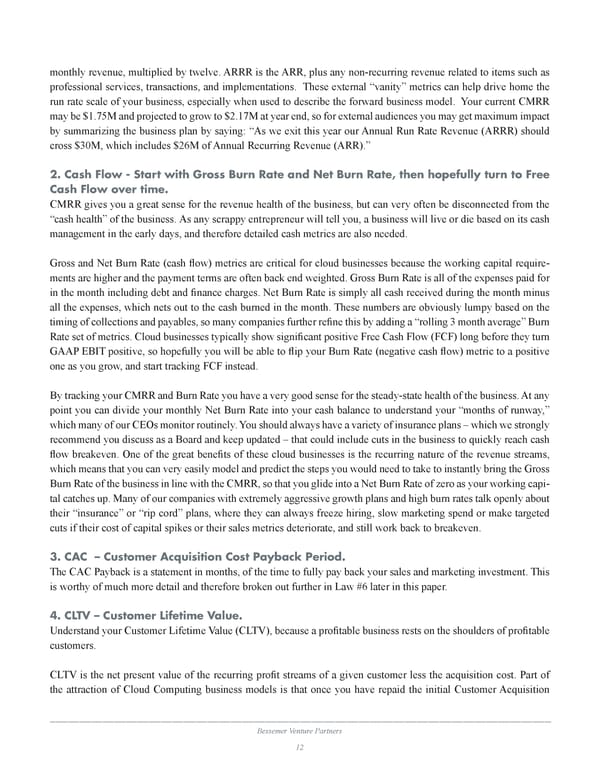monthly revenue, multiplied by twelve. ARRR is the ARR, plus any non-recurring revenue related to items such as professional services, transactions, and implementations. These external “vanity” metrics can help drive home the run rate scale of your business, especially when used to describe the forward business model. Your current CMRR may be $1.75M and projected to grow to $2.17M at year end, so for external audiences you may get maximum impact by summarizing the business plan by saying: “As we exit this year our Annual Run Rate Revenue (ARRR) should cross $30M, which includes $26M of Annual Recurring Revenue (ARR).” 2. Cash Flow - Start with Gross Burn Rate and Net Burn Rate, then hopefully turn to Free Cash Flow over time. CMRR gives you a great sense for the revenue health of the business, but can very often be disconnected from the “cash health” of the business. As any scrappy entrepreneur will tell you, a business will live or die based on its cash management in the early days, and therefore detailed cash metrics are also needed. Gross and Net Burn Rate (cash flow) metrics are critical for cloud businesses because the working capital require- ments are higher and the payment terms are often back end weighted. Gross Burn Rate is all of the expenses paid for in the month including debt and finance charges. Net Burn Rate is simply all cash received during the month minus all the expenses, which nets out to the cash burned in the month. These numbers are obviously lumpy based on the timing of collections and payables, so many companies further refine this by adding a “rolling 3 month average” Burn Rate set of metrics. Cloud businesses typically show significant positive Free Cash Flow (FCF) long before they turn GAAP EBIT positive, so hopefully you will be able to flip your Burn Rate (negative cash flow) metric to a positive one as you grow, and start tracking FCF instead. By tracking your CMRR and Burn Rate you have a very good sense for the steady-state health of the business. At any point you can divide your monthly Net Burn Rate into your cash balance to understand your “months of runway,” which many of our CEOs monitor routinely. You should always have a variety of insurance plans – which we strongly recommend you discuss as a Board and keep updated – that could include cuts in the business to quickly reach cash flow breakeven. One of the great benefits of these cloud businesses is the recurring nature of the revenue streams, which means that you can very easily model and predict the steps you would need to take to instantly bring the Gross Burn Rate of the business in line with the CMRR, so that you glide into a Net Burn Rate of zero as your working capi- tal catches up. Many of our companies with extremely aggressive growth plans and high burn rates talk openly about their “insurance” or “rip cord” plans, where they can always freeze hiring, slow marketing spend or make targeted cuts if their cost of capital spikes or their sales metrics deteriorate, and still work back to breakeven. 3. CAC – Customer Acquisition Cost Payback Period. The CAC Payback is a statement in months, of the time to fully pay back your sales and marketing investment. This is worthy of much more detail and therefore broken out further in Law #6 later in this paper. 4. CLTV – Customer Lifetime Value. Understand your Customer Lifetime Value (CLTV), because a profitable business rests on the shoulders of profitable customers. CLTV is the net present value of the recurring profit streams of a given customer less the acquisition cost. Part of the attraction of Cloud Computing business models is that once you have repaid the initial Customer Acquisition Bessemer Venture Partners 12
 Bessemer’s Top 10 Laws of Cloud Computing Page 11 Page 13
Bessemer’s Top 10 Laws of Cloud Computing Page 11 Page 13